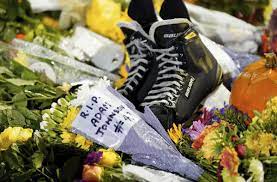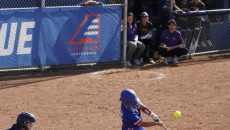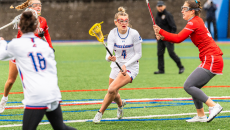(Photo courtesy of the Colgate Maroon-News) “Community members leave flowers in memorial of Adam Johnson”
Sarah Mahannah
Connector Editor
The death of former Pittsburgh Penguins player Adam Johnson from an on-ice accident had stirred up movements to mandate protective hockey equipment. On Oct. 28, the 29-year-old died after being slashed in the neck by a skate blade during an English league hockey game between the Nottingham Panthers and the Sheffield Steelers.
In the weeks following Johnson’s death, hockey players and organizations have called for neck guard mandates, especially in the National Hockey League (NHL). Neck guards are designed to prevent a cut to the neck. They are normally just protective gear or embedded into a turtleneck long sleeve.
In response to Johnson’s death, the Western Hockey League, the Pittsburgh Penguins ECHL and American Hockey League (AHL) teams now require players to wear neck guards. The English Ice Hockey Association will also require players to wear neck guards beginning in 2024.
While the NHL hasn’t yet announced it will mandate neck protection, many fans and players feel that because of a history of events similar to Johnson’s, the NHL should require neck guards.
Some fans online have noted that they think it is odd that the NHL does not require this protective equipment already, but surprisingly the NHL didn’t require players to wear helmets until 1979, and it wasn’t until 2013 that they required players to wear visors that can prevent eye injuries.
A few players have already started wearing neck guards to protect themselves since Johnson’s death. Penguins defenseman Erik Karlsson has been spotted wearing a guard, telling ESPN, “if we can wear a small piece of equipment to hopefully prevent something like [what happened to Johnson] again, I think that’s a win.”
While it may feel like the league will not budge and change mandates, many players are optimistic things can change. Defenseman Ryan Graves said “it’s available for a reason… you wear it all through minor hockey. If you look back [to] 15 years ago, nobody wore visors. I would never play without one now. So maybe [the neck guard] will just be part of it.”
There have been instances of players in the past resisting wearing protective gear because of being uncomfortable or feeling that it weakens signaling. But it seems that hockey culture has moved to be more accepting of adding safety measures to protect the lives and careers of players.
One large reason that neck guards have never been required in the NHL is because most of the time when a player is hit in the neck with a blade, it is not severe. Also, slashes to the neck with a skate blade are rare.
This is backed up by a 2009 study to learn more about USA Hockey players’ understanding of skate blade cuts. Dr. Michael J Stuart of the Clinical Journal of Sports Medicine and his fellow researchers surveyed over 20,000 players for this study.
They concluded that 45 percent of players reported wearing a neck guard while playing hockey, and only two percent sustained a cut to the neck area by a skate blade. It is important to note that most of the players who participated in the study were between the ages of 13 and 18. The researchers also found that almost 25 percent of players had received a slash to the neck at one point in their time playing hockey.
While it is shown that neck injuries are less common in the NHL, some players think that if younger players are shown that one can become accustomed to neck guards, more younger people joining the league in the future will change the culture.
Washington Capitals player T.J. Oshie has been an advocate for neck guards and started wearing one after Johnson’s death. Oshie said “for youth, I hope it shows them that it’s really not a distraction from my game. I played pretty decent tonight. Actually, it was really comfortable.”
As for now, NHL players will be free to choose if they want to wear neck guards. If neck guards are not required by the NHL, it may take a while for them to become more popular.
(Editors Note: Name of a league has been corrected)




